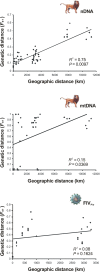The evolutionary dynamics of the lion Panthera leo revealed by host and viral population genomics
- PMID: 18989457
- PMCID: PMC2572142
- DOI: 10.1371/journal.pgen.1000251
The evolutionary dynamics of the lion Panthera leo revealed by host and viral population genomics
Abstract
The lion Panthera leo is one of the world's most charismatic carnivores and is one of Africa's key predators. Here, we used a large dataset from 357 lions comprehending 1.13 megabases of sequence data and genotypes from 22 microsatellite loci to characterize its recent evolutionary history. Patterns of molecular genetic variation in multiple maternal (mtDNA), paternal (Y-chromosome), and biparental nuclear (nDNA) genetic markers were compared with patterns of sequence and subtype variation of the lion feline immunodeficiency virus (FIV(Ple)), a lentivirus analogous to human immunodeficiency virus (HIV). In spite of the ability of lions to disperse long distances, patterns of lion genetic diversity suggest substantial population subdivision (mtDNA Phi(ST) = 0.92; nDNA F(ST) = 0.18), and reduced gene flow, which, along with large differences in sero-prevalence of six distinct FIV(Ple) subtypes among lion populations, refute the hypothesis that African lions consist of a single panmictic population. Our results suggest that extant lion populations derive from several Pleistocene refugia in East and Southern Africa ( approximately 324,000-169,000 years ago), which expanded during the Late Pleistocene ( approximately 100,000 years ago) into Central and North Africa and into Asia. During the Pleistocene/Holocene transition ( approximately 14,000-7,000 years), another expansion occurred from southern refugia northwards towards East Africa, causing population interbreeding. In particular, lion and FIV(Ple) variation affirms that the large, well-studied lion population occupying the greater Serengeti Ecosystem is derived from three distinct populations that admixed recently.
Conflict of interest statement
The authors have declared that no competing interests exist.
Figures




References
-
- Werdelin L, Lewis ME. Plio-Pleistocene Carnivora of eastern Africa: species richness and turnover patterns. Zool J Linn Soc. 2005;144:121–144.
-
- Petter G. Carnivores Pléistocènes du Ravin d'Olduvai (Tanzanie). In: Leakey LSB, Savage RJG, Coryndon SC, , editors. Fossil vertebrates of Africa. Vol. 3. London: Academic Press; 1973. pp. 43–100.
-
- Hemmer H. Untersuchungen zur Stammesgeschichte der Pantherkatzen (Pantherinae) Teil 3. Zur Artgeschichte de Löwen Panthera (Panthera) leo (Linnaeus, 1758). Veröffentlichungen der Zoologischen Staatssammlung. 1974;17:167–280.
-
- Bauer H, Nowell K. Panthera leo. IUCN 2006. 2006. 2006 IUCN Red List of Threatened Species ( http://www.iucnredlist.org/search/details.php/15951/all)
-
- O'Brien SJ, Martenson JS, Packer C, Herbst L, De Vos V, Joslin P, Ott-Joslin J, Wildt DE, Bush M. Biochemical genetic variation in geographic isolates of African and Asiatic lions. National Geographic Research. 1987;3:114–124.
Publication types
MeSH terms
Substances
Grants and funding
LinkOut - more resources
Full Text Sources
Miscellaneous

